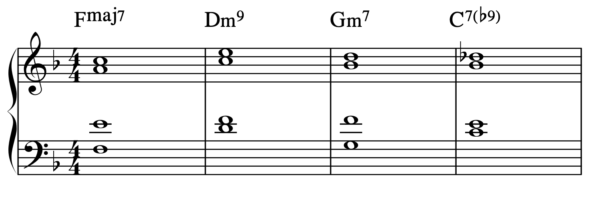Chord substitution
In this article we will explore chord substitution. This phrase is exactly as it sounds: we replace one chord with another. This will result in increased harmonic options that will enhance your solos.
Chord substitution: major to minor and minor to major
Let’s begin with a very easy chord substitution. Take a major 7 chord, 1-3-5-7, and then play its inversion building from the 3. This results in 3-5-7-9. Here’s an example. My original chord is Fmaj7 and its chord substitute is Amin7.

Now look at this basic I-VI-II-V sequence in F major.

I will now swap the F major 7 in bar 1 to A minor 7.

Here’s a short solo over these four bars. Notice in bar 3 I’m playing a broken chord of Bbmaj7 but am retaining the G shell in my left hand. In Bar 4 I am playing a diminished broken chord over C7(b9).

Chord substitution of a minor 7 chord with a dominant 7.
I could now take both the Dm7 and Gm7 and substitute them for for D7 and G7

As I’ve said many times before, dominant 7 chords furnish us with greater harmonic possibilities such as option to add altered notes (alterations).
In the next example my chord sequence is a pretty regular turnaround
but notice the broken chords I play in the right hand at bars 3 and 4.

And here’s my YouTube video about chord substitution.
To subscribe to my full online video course click here.